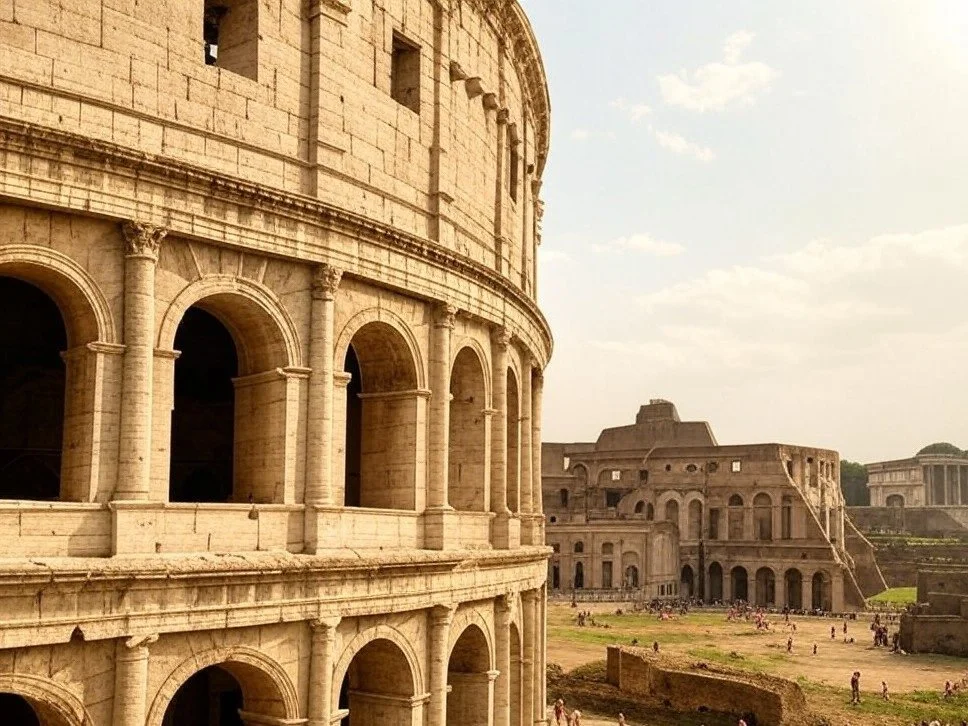The Colosseum, also known as the Flavian Amphitheatre, stands as one of the most iconic symbols of ancient Roman engineering and architecture. Completed in 80 CE under Emperor Titus, this grand structure was a testament to Roman ingenuity and a central hub of social and cultural life. The Colosseum's construction involved advanced engineering techniques, and its preservation continues to be a focus of modern archaeological efforts.
Engineering Techniques: A Feat of Roman Innovation
The construction of the Colosseum was a monumental undertaking that showcased the Romans' mastery of engineering and architecture. Several key techniques and materials were employed to create this enduring structure.
Materials and Design
Concrete: The Romans pioneered the use of concrete, which was a crucial material in the construction of the Colosseum. Made from a mixture of lime, volcanic sand, and water, Roman concrete was both durable and versatile, allowing for the creation of large, complex structures.
Travertine and Tuff: The primary building materials were travertine limestone and tuff (volcanic rock). Travertine was used for the outer walls and load-bearing elements, while tuff, being lighter, was used for the upper levels and internal structures.
Brick and Mortar: Brick and mortar were used extensively for the interior walls and vaults. This combination provided flexibility and strength, enabling the construction of the Colosseum's intricate arches and passageways.
Architectural Features
Elliptical Design: The Colosseum's elliptical shape, measuring approximately 189 meters long and 156 meters wide, was designed to accommodate up to 50,000 spectators. This shape also provided excellent sightlines and efficient crowd management.
Tiered Seating: The seating was divided into three main tiers, with additional standing room at the top. Each tier was reserved for different social classes, reflecting the hierarchical nature of Roman society.
Hypogeum: Beneath the arena floor was the hypogeum, a complex network of tunnels and chambers used to house animals, gladiators, and stage machinery. This underground area was equipped with elevators and trapdoors to facilitate the dramatic entrances of participants and animals.
Velarium: The Colosseum featured a retractable awning known as the velarium, which provided shade for spectators. This massive canvas canopy was supported by a system of ropes and masts, demonstrating the Romans' advanced understanding of engineering and mechanics.
Role in Roman Society: A Center of Spectacle and Social Order
The Colosseum was more than just an architectural marvel; it was a central institution in Roman society, serving various social, political, and cultural functions.
Entertainment and Spectacle
Gladiatorial Games: The Colosseum was primarily known for its gladiatorial contests, where trained fighters battled each other, wild animals, and condemned criminals. These games were a popular form of entertainment and a way for emperors to display their power and generosity.
Animal Hunts: Venationes, or animal hunts, were another major attraction. Exotic animals from across the empire were brought to the Colosseum to participate in staged hunts and battles.
Public Executions: The Colosseum also hosted public executions, often in the form of reenactments of mythological scenes or naval battles (naumachiae), where the arena was flooded for the spectacle.
Social and Political Functions
Imperial Propaganda: The Colosseum served as a tool for imperial propaganda. Emperors used the games to gain favor with the populace, demonstrating their wealth and commitment to public welfare.
Social Hierarchy: The seating arrangement reinforced social hierarchies, with the best seats reserved for the elite and the upper tiers for the common people. This stratification reflected and reinforced the social order of Roman society.
Archaeological Efforts: Preserving a Legacy
The preservation of the Colosseum has been a focus of extensive archaeological and conservation efforts, ensuring that this ancient marvel continues to inspire and educate future generations.
Restoration and Conservation
19th and 20th Centuries: Major restoration efforts began in the 19th century, focusing on stabilizing the structure and preventing further deterioration. These efforts continued into the 20th century, with the removal of vegetation and the reinforcement of weakened sections.
Modern Techniques: Today, advanced technologies, such as laser scanning and 3D modeling, are used to monitor the Colosseum's condition and guide restoration efforts. These techniques allow for precise documentation and analysis of the structure.
Public Engagement and Education
Tourism: The Colosseum is one of Rome's most popular tourist attractions, drawing millions of visitors each year. Efforts to manage tourism and minimize environmental impact are crucial for its preservation.
Educational Programs: The Colosseum serves as an educational resource, offering insights into Roman engineering, architecture, and society. Exhibits and guided tours provide context and enhance public understanding of this ancient monument.
Conclusion
The Colosseum stands as a testament to the ingenuity and ambition of ancient Roman engineering. Its construction involved advanced techniques and materials, resulting in a structure that has endured for nearly two millennia. As a center of entertainment and social order, the Colosseum played a vital role in Roman society, reflecting the complexities and hierarchies of the time. Modern archaeological and conservation efforts continue to preserve this iconic monument, ensuring that the legacy of the Colosseum remains a source of inspiration and knowledge for generations to come. Through the study and preservation of the Colosseum, we gain a deeper appreciation for the achievements of ancient Rome and the enduring impact of its architectural marvels.







